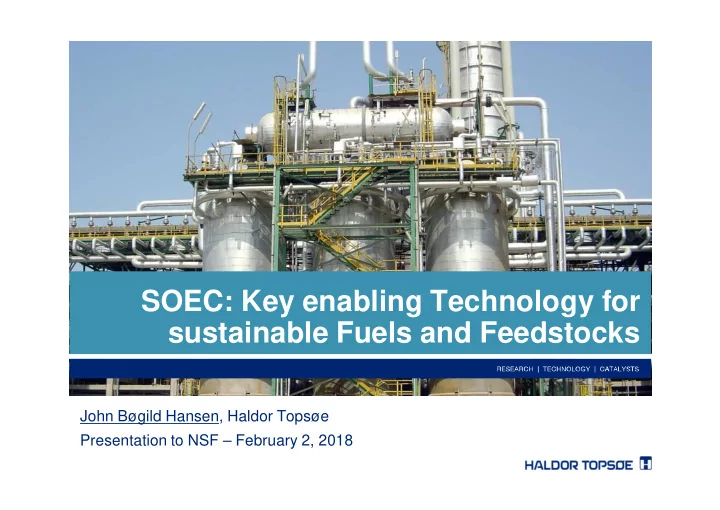

SOEC: Key enabling Technology for sustainable Fuels and Feedstocks John Bøgild Hansen, Haldor Topsøe Presentation to NSF – February 2, 2018
Fuel Cell and Electrolyser SOFC SOEC H 2 O H 2 H 2 H 2 O H 2 + O 2- → H 2 O + 2e - H 2 O + 2e - → H 2 + O 2- O 2- O 2- ½O 2 + 2e - → O 2- O 2- → 2e - +½O 2 ½O 2 ½O 2 SOFC H 2 O + CO 2 + electric energy ( ∆ G) + heat (T ∆ S) H 2 + CO + O 2 SOEC
SOEC more efficient than present Electrolysers Internal waste heat used to split water 4.0 Energy needed to evaporate water 3.5 3.0 Waste heat which can be utilised to split water kWh per Nm3 H2 2.5 2.0 1.5 Minimum Electricity Input 1.0 0.5 0.0 0 100 200 300 400 500 600 700 800 900 1000 Deg C.
SOEC Electrolysis Hydrogen SNG CO Power Methanol H 2 Steam DME CO 2 CO 2 Gasoline Diesel CO Syngas
Cell Development from 1989 MSC LSCF ASC CGO YSZ or SSZ FeCr 3G metallic support ESC LSCF LSM LSM CGO YSZ YSZ YSZ or SSZ Ni/YSZ Ni/YSZ Ni/YSZ 1G 2.XG 2.5G Cell generations with ceramic support 850 o C 750 o C 600 o C 1000 o C Performance– Robustness – Cost reduction
Development of stacks Design for Base case design: robustness Design for 75 cells 12x12 cm 2 manufacturability TOFC Incremental development Platform towards and industrial product Stack
CO from CO 2 by SOEC electrolytic process Commercially available – Biggest plant so far 250 kW Electrochemical reaction at the fuel electrode side �� � + 2 � � → �� + � �� � �� → � � � � + 2 � � Production of oxygen-rich gas
Biogas upgrade by means of SOEC CH 4 + CO 2 + 3H 2 O + El 2CH 4 +H 2 O + 2O 2
SNG Technology Methanation generates a lot of heat CO 2 + 4H 2 ↔ CH 4 + 2H 2 O (- ∆ H = 165 kJ/mol) Syngas = SNG + heat Energy: 100% = 80% + 20% Heat 20% 100% SNG 80%
Biogas to SNG via SOEC and methanation of the CO 2 in the biogas:
Exergy Flows in CO 2 case
Synergy between SOEC and fuel synthesis Product Synthesis SOEC CO 2 Syn Gas H 2 O Steam
Methanation and SOEC at Foulum
Production (100 % = 10 Nm 3 /h CH 4 ) vs hours on stream. 3.1 kWh/Nm 3 H 2 860 120% 840 100% Percent of Design production 820 800 80% 780 60% 760 740 40% 720 20% 700 680 0% 0 500 1000 1500 2000 2500 Hours on Electrolysis
Methanator catalyst very active and stable
Transient operation of methanator
Average gas compositions June 2, 2016 Position CH 4 CO 2 N 2 H 2 Inlet 56 43 1 0 Exit 1 st 94.58 0.27 0.91 4.23 stage Product 97.69 0.00 0.95 1.36 gas
Key numbers Denmark (2008) ¡ Final energy consumption: 673 PJ ¡ Biogas potential: 40 PJ ¡ If upgraded by SOEC: 67 PJ ~ 10 % ¡ NG used for power plants: 73 PJ ¡ NG used in household, industry and service: 76 PJ ¡ Saved CO 2 ~ 1 MT/capita
Methanol synthesis Ø CO + 2H 2 = CH 3 OH + 91 kJ/mol Ø CO 2 + 3H 2 = CH 3 OH+H 2 O + 41 kJ/mol
The Active Site of Syngas Catalyst H 2 H 2 /H 2 O Cu is metallic Cu(200), Cu(111) d=0.18nm when catalyzing: Cu(111) - WGS Cu(111), - MeOH synthesis d=0.21nm - MeOH reforming ZnO(012), ZnO(011), d=0.19nm d=0.25nm Catalyst dynamic: - Number of active sites depends on conditions 1.5mbar, 220 o C 1.5mbar, H 2 /H 2 O=3/1, 220 o C
Conversion of methanol as function of CO 2 content in stoichiometric gas 100 90 J.B. Hansen Data Condensing methanol 80 Carbon conversion % 70 60 50 40 K.Klier Data Lab data 225 C 30 20 10 0 0 5 10 15 20 25 30 Percent CO2 in
Methanol from CO 2 and Steam SOEC Oxygen Water CO 2 Recycle synthesis Methan ol Purge Separator Methanol
Space velocity and byproducts as function of CO 2 converted in SOEC 500 1300 Space velocity Relative % 400 1000 Byproducts Relative % 300 700 Space Velocity 200 400 Byproducts 100 100 0 20 40 60 80 100 Percent CO2 through SOEC
Results of ”to pressurize SOEC stacks or not” SOEC Syngas CO 2 LHV Pressure Comp , % Comp Efficiency , % Atmospheric 6.8 0.1 75.8 @50 bar 0.0 1.9 79.5 Max. theoretical 83-88
Heat of Reactions per mole H 2 @ 280 ° C Product From CO From CO 2 kJ/mol kJ/mol Gasoline 79 37 CH 4 72 44 DME 55 24 MeOH 50 20 Evaporation of 1 mol of water requires ~ 48 kJ @ 25 – 60 bar g NB: Steam conversion is only 70 – 80 % in SOEC plants
From SOEC Science to Commercial Product Reliability Lifetime & Performance Materials Design Processing Cost
Energinet.dk’s vision for fossil fuel free Denmark in 2050 – The Wind Scenario El- Transmission Peak Shave: High priced SOEC Gas Turbine Low priced SOFC Electrolysis District Heating DH Heat O2 Gas Green Synfuels Cleaning Catalysis: Gasifier/ Biomass System MeOH, DME Digester Gasoline, SNG Storage DH District Heating District Heating Upgrade Air Capture To Compress Methane Gas Transmission
CEESA plan requires 4-8 GW electrolysis capacity needed for Denmark
SOEC Challenges ¡ Degradation ¡ Better defined testing protocols? ¡ Understanding of fundamental mechanisms ¡ Robustness ¡ Pressurisation ¡ Upscaling geometric area ¡ Upscaling manufacturing ¡ And of course cost
Recommend
More recommend